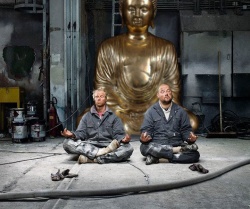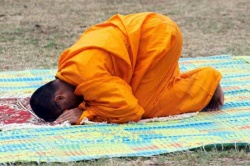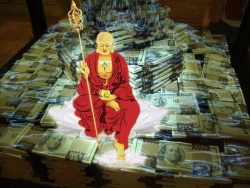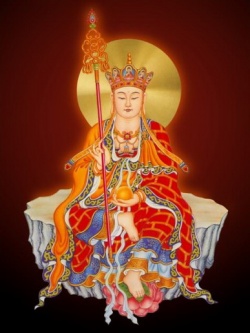Difference between revisions of "Agnivesha Samhita"
(Created page with " Charaka Samhita is a huge treatise on {{Wiki|ancient Indian}} medicine. It contains eight divisions (ashtanga sthanas) viz., sutra, nidana, vimana,...") |
|||
| Line 1: | Line 1: | ||
| + | <nomobile>{{DisplayImages|1490|3696|4246|339|4433|724}}</nomobile> | ||
| + | |||
| + | |||
| + | |||
| + | |||
| + | |||
| + | |||
| + | |||
| − | [[Charaka Samhita]] is a huge treatise on {{Wiki|ancient Indian}} [[medicine]]. It contains eight divisions ([[ashtanga]] sthanas) viz., [[sutra]], [[nidana]], [[vimana]], sharia, [[indriya]], chikitsa, [[kalpa]] and [[siddha]] | + | [[Charaka Samhita]] is a huge treatise on {{Wiki|ancient Indian}} [[medicine]]. |
| + | |||
| + | It contains eight divisions ([[ashtanga]] sthanas) viz., [[sutra]], [[nidana]], [[vimana]], [[sharia]], [[indriya]], [[chikitsa]], [[kalpa]] and [[siddha sthanas]]. | ||
| + | |||
| + | Each [[division]] is further divided into numerous chapters, it describes not only the [[existing]] [[knowledge]] about [[medicine]] aspects but also the [[logic]] and [[philosophy]] behind the {{Wiki|medical}} systems. | ||
The {{Wiki|present}} {{Wiki|manuscript}} of [[Charaka Samhita]] has a long history behind it. | The {{Wiki|present}} {{Wiki|manuscript}} of [[Charaka Samhita]] has a long history behind it. | ||
| − | As stated earlier, it was originally composed by [[Agnivesa]] one of the six students of [[Atreya]], and it [[embodied]] the teachings of the [[latter]]. Agnivesha's treatise appears to have been available till the eleventh century, as Chakrapanidatta, its commentator, quotes from it. | + | As stated earlier, it was originally composed by [[Agnivesa]] one of the six students of [[Atreya]], and it [[embodied]] the teachings of the [[latter]]. [[Agnivesha's]] treatise appears to have been available till the eleventh century, as [[Chakrapanidatta]], its commentator, quotes from it. |
| + | |||
| + | With the passage of time, as new [[knowledge]] [[accumulated]], it looks, it was felt necessary that [[Agnivesha tantra]] should be revised. | ||
| − | + | This was done by [[Charaka]] and the revised edition of [[Agnivesha tantra]] came to be called [[Charaka Samhita]]. | |
| − | + | During the ninth century, [[Charaka Samhita]] was again edited and reconstructed by a [[Kashmiri]] [[Pandit]] named [[Dridhabala]], son of [[Kapilabala]], a resident of Panchanadapura, now known as Panjor situated seven {{Wiki|miles}} [[north]] of [[Srinagar]]. | |
| − | + | The {{Wiki|present}} [[form]] which [[Charaka Samhita]] has, was given to it by [[Dridhabala]]. | |
| − | + | He not only added the missing chapters but also edited the whole [[samhita]]. | |
| Line 20: | Line 34: | ||
It describes {{Wiki|etiology}}, {{Wiki|classification}}, {{Wiki|pathology}}, diagnosis treatment of various {{Wiki|diseases}} and the [[science]] of rejuvenation of the [[body]]. | It describes {{Wiki|etiology}}, {{Wiki|classification}}, {{Wiki|pathology}}, diagnosis treatment of various {{Wiki|diseases}} and the [[science]] of rejuvenation of the [[body]]. | ||
| − | It discusses elaborately the {{Wiki|etiology}} of {{Wiki|diseases}} on the basis of the tridosa {{Wiki|theory}}. | + | It discusses elaborately the {{Wiki|etiology}} of {{Wiki|diseases}} on the basis of the [[tridosa]] {{Wiki|theory}}. |
| − | It gives a detailed description of the various {{Wiki|diseases}} including those of the [[eyes]], the {{Wiki|female}} {{Wiki|genital}} {{Wiki|organs}}, normal and abnormal deliveries and {{Wiki|diseases}} of the children. Charaka's [[materia medica]] consists chiefly of vegetable products though [[animal]] and earthy products are also included in it. | + | It gives a detailed description of the various {{Wiki|diseases}} including those of the [[eyes]], the {{Wiki|female}} {{Wiki|genital}} {{Wiki|organs}}, normal and abnormal deliveries and {{Wiki|diseases}} of the children. [[Charaka's]] [[materia medica]] consists chiefly of vegetable products though [[animal]] and earthy products are also included in it. |
All these [[drugs]] are classified into 50 groups on the basis of their [[action]] on the [[body]]. | All these [[drugs]] are classified into 50 groups on the basis of their [[action]] on the [[body]]. | ||
| − | This vast treatise also gives an [[idea]] of the various categories of the practitioners of the [[healing]] [[art]], specialization in different {{Wiki|medical}} [[subjects]], physicians and their fees, nursing care, centers of {{Wiki|medical}} {{Wiki|learning}}, schools of [[philosophy]] such as [[Nyaya]] and [[Vaiseshika]] which formed the [[fundamental basis]] of {{Wiki|medical}} theories, {{Wiki|medical}} botany and {{Wiki|classification}} of the [[animal kingdom]], particularly in regard to properties of their flesh etc. | + | This vast treatise also gives an [[idea]] of the various categories of the practitioners of the [[healing]] [[art]], specialization in different {{Wiki|medical}} [[subjects]], physicians and their fees, nursing care, centers of {{Wiki|medical}} {{Wiki|learning}}, |
| + | |||
| + | schools of [[philosophy]] such as [[Nyaya]] and [[Vaiseshika]] which formed the [[fundamental basis]] of {{Wiki|medical}} theories, {{Wiki|medical}} botany and {{Wiki|classification}} of the [[animal kingdom]], particularly in regard to properties of their flesh etc. | ||
It also describes various customs, [[tradition]], {{Wiki|legends}}, routine of daily [[life]], [[habits]] of [[smoking]] and drinking, dress and clothing of the [[people]] of that {{Wiki|era}}. | It also describes various customs, [[tradition]], {{Wiki|legends}}, routine of daily [[life]], [[habits]] of [[smoking]] and drinking, dress and clothing of the [[people]] of that {{Wiki|era}}. | ||
| − | Commentary on [[Charaka Samhita]] by Chakrapanidatta, called [[Charaka | + | Commentary on [[Charaka Samhita]] by [[Chakrapanidatta]], called [[Charaka Tatparya-Tika]] or [[Ayurveda Dipika]], done in the eleventh century (A.D. 1066), is very famous. |
| − | [[Charaka Samhita]] was translated from [[Sanskrit]] into [[Arabic]] in the beginning of the eighth century and its [[name]] Sharaka Indianus occurs in the {{Wiki|Latin}} translation of {{Wiki|Avicenna}}, Razes, | + | |
| + | [[Charaka Samhita]] was translated from [[Sanskrit]] into [[Arabic]] in the beginning of the eighth century and its [[name]] [[Sharaka Indianus]] occurs in the {{Wiki|Latin}} translation of {{Wiki|Avicenna}}, Razes, | ||
| + | |||
| + | and [[Serapion]], a translation of the [[Karka]] from [[Sanskrit]] into [[Persian]] and from [[Persian]] into [[Arabic]] is mentioned in the Fihrst (finished in A.D. 987). | ||
| + | |||
| + | It is likewise mentioned by [[Alberuni]]. | ||
| + | |||
| + | [[Charaka Samhita]] was first translated into English by [[A.C. Kaviratnain]] 1897. | ||
| − | |||
The [[life]] and times of [[Charaka]] are not known with {{Wiki|certainty}}. | The [[life]] and times of [[Charaka]] are not known with {{Wiki|certainty}}. | ||
| Line 42: | Line 64: | ||
Some [[Indian]] [[scholars]] have stated that [[Charaka]] of [[Charaka Samhita]] existed before [[Panini]], the grammarian, who is said to have lived before the sixth century B. C. | Some [[Indian]] [[scholars]] have stated that [[Charaka]] of [[Charaka Samhita]] existed before [[Panini]], the grammarian, who is said to have lived before the sixth century B. C. | ||
| − | Another school argues that [[Wikipedia:Patanjali|Patanjali's]] wrote a commentary on the {{Wiki|medical}} work of [[Charaka]], which is corroborated by his commentator, Chakrapanidatta. | + | Another school argues that [[Wikipedia:Patanjali|Patanjali's]] wrote a commentary on the {{Wiki|medical}} work of [[Charaka]], which is corroborated by his commentator, [[Chakrapanidatta]]. |
They say that if [[Wikipedia:Patanjali|Patanjali's]] lived around 175 B.C., [[Charaka]] must have lived some time before him. | They say that if [[Wikipedia:Patanjali|Patanjali's]] lived around 175 B.C., [[Charaka]] must have lived some time before him. | ||
| Line 53: | Line 75: | ||
Till such time as further and more conclusive {{Wiki|evidence}} is available, to narrow down this period would not be justifiable. | Till such time as further and more conclusive {{Wiki|evidence}} is available, to narrow down this period would not be justifiable. | ||
| + | {{R}} | ||
| + | http://hinduonline.co/Scriptures/Samhita/CharakaSamhita.html | ||
| + | [[Category:Ayurveda]] | ||
Latest revision as of 09:59, 13 December 2015
Charaka Samhita is a huge treatise on ancient Indian medicine.
It contains eight divisions (ashtanga sthanas) viz., sutra, nidana, vimana, sharia, indriya, chikitsa, kalpa and siddha sthanas.
Each division is further divided into numerous chapters, it describes not only the existing knowledge about medicine aspects but also the logic and philosophy behind the medical systems.
The present manuscript of Charaka Samhita has a long history behind it.
As stated earlier, it was originally composed by Agnivesa one of the six students of Atreya, and it embodied the teachings of the latter. Agnivesha's treatise appears to have been available till the eleventh century, as Chakrapanidatta, its commentator, quotes from it.
With the passage of time, as new knowledge accumulated, it looks, it was felt necessary that Agnivesha tantra should be revised.
This was done by Charaka and the revised edition of Agnivesha tantra came to be called Charaka Samhita.
During the ninth century, Charaka Samhita was again edited and reconstructed by a Kashmiri Pandit named Dridhabala, son of Kapilabala, a resident of Panchanadapura, now known as Panjor situated seven miles north of Srinagar.
The present form which Charaka Samhita has, was given to it by Dridhabala.
He not only added the missing chapters but also edited the whole samhita.
Charaka Samhita deals elaborately with subjects such as foetal generation and development, anatomy of the human body, function and malfunction of the body depending upon the equilibrium or otherwise of the three humours of the body, viz., of vayu, pitta and kapha.
It describes etiology, classification, pathology, diagnosis treatment of various diseases and the science of rejuvenation of the body.
It discusses elaborately the etiology of diseases on the basis of the tridosa theory.
It gives a detailed description of the various diseases including those of the eyes, the female genital organs, normal and abnormal deliveries and diseases of the children. Charaka's materia medica consists chiefly of vegetable products though animal and earthy products are also included in it.
All these drugs are classified into 50 groups on the basis of their action on the body.
This vast treatise also gives an idea of the various categories of the practitioners of the healing art, specialization in different medical subjects, physicians and their fees, nursing care, centers of medical learning,
schools of philosophy such as Nyaya and Vaiseshika which formed the fundamental basis of medical theories, medical botany and classification of the animal kingdom, particularly in regard to properties of their flesh etc.
It also describes various customs, tradition, legends, routine of daily life, habits of smoking and drinking, dress and clothing of the people of that era.
Commentary on Charaka Samhita by Chakrapanidatta, called Charaka Tatparya-Tika or Ayurveda Dipika, done in the eleventh century (A.D. 1066), is very famous.
Charaka Samhita was translated from Sanskrit into Arabic in the beginning of the eighth century and its name Sharaka Indianus occurs in the Latin translation of Avicenna, Razes,
and Serapion, a translation of the Karka from Sanskrit into Persian and from Persian into Arabic is mentioned in the Fihrst (finished in A.D. 987).
It is likewise mentioned by Alberuni.
Charaka Samhita was first translated into English by A.C. Kaviratnain 1897.
The life and times of Charaka are not known with certainty.
Some Indian scholars have stated that Charaka of Charaka Samhita existed before Panini, the grammarian, who is said to have lived before the sixth century B. C.
Another school argues that Patanjali's wrote a commentary on the medical work of Charaka, which is corroborated by his commentator, Chakrapanidatta.
They say that if Patanjali's lived around 175 B.C., Charaka must have lived some time before him.
Another source about the identity of Charaka and his times is provided by the French orientalist Sylvan Levi.
He discovered in the Chinese translation of the Buddhist Tripitaka, a person named Charaka who was a court physician to the Indo-Scythian king Kanishka, who in all probability reigned in the second century A.D.
From the above discussion, it would seem that Charaka may have lived between the second century B.C. to the second century A.D.
Till such time as further and more conclusive evidence is available, to narrow down this period would not be justifiable.
Source
http://hinduonline.co/Scriptures/Samhita/CharakaSamhita.html





